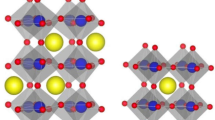
Overview
- Total energy and band structure information of possible elements combined with hydrogen in the NaCl-type lattice
- Contains tight-binding parameterizations in orthogonal, non-orthogonal, three-centre, and two-centre representations
- Provides a selection of the computer code implemented for the reader's own use
Access this book
Tax calculation will be finalised at checkout
Other ways to access
About this book
This book compiles detailed results of electronic structure calculations for most possible cubic monohydrides, dihydrides and selected trihydrides related to superconductivity, comprising elements with atomic numbers up to 103. Beginning with an introduction to the theory and details of the computational methods implemented, this handbook presents a collection of chapters containing results for different classes of cubic hydrides, featuring tables of three-centre and two-centre tight-binding parameterizations, diagrams of energy bands, and densities of states with angular momentum decomposition. Equilibrium lattice parameters and bulk moduli are also included, along with the electron-ion matrix element (Hopfield-McMillan parameter), Stoner criterion for ferromagnetism and values of Fermi velocities and plasmon energies. Each chapter features a brief text explaining the results presented with comparison to experimental values when available. A selection of the implemented computer codes is reproduced for the reader’s own use. This handbook is an ideal complement to any standard electronic structure text for students and researchers in materials science, condensed matter physics, and quantum chemistry.
Similar content being viewed by others
Keywords
Table of contents (17 chapters)
-
Front Matter
-
Back Matter
Authors and Affiliations
About the author
Dimitrios A. Papaconstantopoulos was born in Athens, Greece, and graduated from the University of Athens with a B.S. degree in physics in 1961. He received a PhD in theoretical solid state physics from the University of London, England, in 1967. He was a professor of physics at George Mason University (GMU) from 1967 to 1977 and chair of the Physics Department from 1974 to 1977. He joined the Naval Research Lab in 1977 and was the director of the Center for Computational Materials Science from 1992 to 2004. He returned to GMU in 2005 as chair of the Department of Computational and Data Sciences. He retired from GMU in 2016 and is currently Professor Emeritus.
His areas of expertise are in computational physics and include band structure calculations, theory of superconductivity, tight-binding formulations and theory of alloys. He has authored/co-authored 290 journal articles, three books and has given numerous presentations at professional meetings. He has won four Alan Berman Research Publication awards and the 1990 Sigma Xi Pure Science Award. He has been a Fellow of the American Physical Society since 1980 and his work has over 12,000 citations in the scientific literature. In August 2000 he was awarded the Navy Meritorious Civilian Service Award.
Bibliographic Information
Book Title: Band Structure of Cubic Hydrides
Authors: Dimitrios A. Papaconstantopoulos
DOI: https://doi.org/10.1007/978-3-031-06878-2
Publisher: Springer Cham
eBook Packages: Physics and Astronomy, Physics and Astronomy (R0)
Copyright Information: The Editor(s) (if applicable) and The Author(s), under exclusive license to Springer Nature Switzerland AG 2023
Hardcover ISBN: 978-3-031-06877-5Published: 21 February 2023
Softcover ISBN: 978-3-031-06880-5Published: 21 February 2024
eBook ISBN: 978-3-031-06878-2Published: 20 February 2023
Edition Number: 1
Number of Pages: XIII, 688
Number of Illustrations: 939 b/w illustrations, 149 illustrations in colour
Topics: Materials Science, general, Quantum Physics, Theoretical and Computational Chemistry, Theoretical and Computational Chemistry



